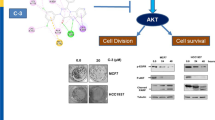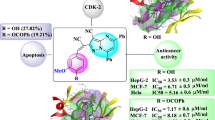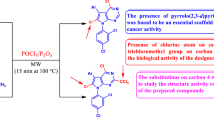Abstract
Pyrazinoic acid or pyrazine-2-carboxylic acid (PA), due to its nitrogenous heteroaromatic ring, can be explored as an anticancer agent. Here, a series of twenty novels PA derivatives have been synthesized and characterized using IR, NMR, and mass spectrums. Their cytotoxic activity was evaluated against three different cancer cell lines, including lung (A549), breast (MCF-7), and colon (HT-29). P16, the most potent compound, showed moderate cytotoxicity with IC50 of 6.11, 10.64, and 14.92 μM, against the A549, MCF-7, and HT-29 cell lines, respectively. Furthermore, the effect of this compound against MRC5 as a non-tumoral lung cell line, exhibited a selectivity index of 9.02. The apoptotic induction activity of P16 was also performed on the A549 cell line. The results showed that as the concentration of the compound increases (from 3 to 6 μM), the percentage of induction of apoptosis increases from 8.54% to 72.4%. Electrophoretic gel mobility shift assays showed that P16 was able to reactive oxygen species (ROS) induce DNA cleavage in the presents of H2O2 (1.0 mM) in high doses. Molecular docking was also applied to anticipate the binding locations and the binding of the synthesized compound with Bcl-2 apoptosis regulator and DNA as their proposed targets.

Graphical abstract





Similar content being viewed by others
References
Sung H, Ferlay J, Siegel RL, Laversanne M, Soerjomataram I, Jemal A, et al. Global cancer statistics 2020: GLOBOCAN estimates of incidence and mortality worldwide for 36 cancers in 185 countries. CA Cancer J Clin. 2021;71:209–49.
Anam F, Abbas A, Lo KM, Hameed S, Naseer MM. Homologous 1, 3, 5-triarylpyrazolines: synthesis, CH⋯ π interactions guided self-assembly and effect of alkyloxy chain length on DNA binding properties. New J Chem. 2014;38:5617–25.
Rana M, Arif R, Khan FI, Maurya V, Singh R, Faizan MI, et al. Pyrazoline analogs as potential anticancer agents and their apoptosis, molecular docking, MD simulation, DNA binding and antioxidant studies. Bioorganic Chem. 2021;108:104665.
Thakor KP, Lunagariya MV, Bhatt BS, Patel MN. Synthesis, characterization and biological applications of some substituted pyrazoline based palladium (II) compounds. Appl Organometal Chem. 2018;32:e4523.
Pistritto G, Trisciuoglio D, Ceci C, Garufi A, D’Orazi G. Apoptosis as anticancer mechanism: function and dysfunction of its modulators and targeted therapeutic strategies. Aging (Albany NY). 2016;8:603.
Abulkhair HS, Turky A, Ghiaty A, Ahmed HE, Bayoumi AH. Novel triazolophthalazine-hydrazone hybrids as potential PCAF inhibitors: Design, synthesis, in vitro anticancer evaluation, apoptosis, and molecular docking studies. Bioorganic Chem. 2020;100:103899.
Fulda S, Debatin K-M. Extrinsic versus intrinsic apoptosis pathways in anticancer chemotherapy. Oncogene. 2006;25:4798–811.
Mermer A, Keles T, Sirin Y. Recent studies of nitrogen containing heterocyclic compounds as novel antiviral agents: a review. Bioorganic Chem. 2021;114:105076.
Gangarapu NR, Reddy EK, Sajith AM, Yellappa S, Chandrasekhar KB. NMI/MsCl‐Mediated amide bond formation of aminopyrazines and Aryl/Heteroaryl Carboxylic acids: synthesis of biologically relevant pyrazine carboxamides. ChemistrySelect. 2017;2:7706–10.
Revill P, Serradell N, Bolos J, Rosa E. Telaprevir. Drugs of the Future. 2007;32:788–98. https://doi.org/10.1358/dof.2007.032.09.1138229.
Schechter LE, Lin Q, Smith DL, Zhang G, Shan Q, Platt B, et al. Neuropharmacological profile of novel and selective 5-HT 6 receptor agonists: WAY-181187 and WAY-208466. Neuropsychopharmacology. 2008;33:1323–35.
Trump DL, Payne H, Miller K, de Bono JS. Stephenson III J, Burris III HA et al. Preliminary study of the specific endothelin a receptor antagonist zibotentan in combination with docetaxel in patients with metastatic castration‐resistant prostate cancer. Prostate. 2011;71:1264–75.
Khani-Meinagh H, Mostafavi H, Reiling N, Mahdavi M, Zarrini G. Design, synthesis and evaluation of biological activities of some novel anti-TB agents with bio-reducible functional group. BioImpacts: BI. 2019;9:199.
Walker JA, Liu W, Wise DS, Drach JC, Townsend LB. Synthesis and antiviral evaluation of certain novel pyrazinoic acid C-nucleosides. J Med Chem. 1998;41:1236–41.
Sahdev AK, Raj V, Singh AK, Rai A, Keshari AK, De A, et al. Ameliorative effects of pyrazinoic acid against oxidative and metabolic stress manifested in rats with dimethylhydrazine induced colonic carcinoma. Cancer Biol Ther. 2017;18:304–13.
Chen D, Frezza M, Schmitt S, Kanwar J, P Dou Q. Bortezomib as the first proteasome inhibitor anticancer drug: current status and future perspectives. Curr Cancer Drug Tar. 2011;11:239–53.
Rotstein BH, Zaretsky S, Rai V, Yudin AK. Small heterocycles in multicomponent reactions. Chem Rev. 2014;114:8323–59.
Gajera SB, Mehta JV, Patel MN. DNA interaction, cytotoxicity, antibacterial and antituberculosis activity of oxovanadium (IV) complexes derived from fluoroquinolones and 4-hydroxy-5-((4-hydroxyphenyl) diazenyl) thiazole-2 (3 h)-thione. RSC Advances. 2015;5:21710–9.
Lim SD, Sun C, Lambeth JD, Marshall F, Amin M, Chung L, et al. Increased Nox1 and hydrogen peroxide in prostate cancer. Prostate. 2005;62:200–7. https://doi.org/10.1002/pros.20137.
Saha B, Islam MM, Paul S, Samanta S, Ray S, Santra CR, et al. DNA binding ability and hydrogen peroxide induced nuclease activity of a novel Cu(II) complex with malonate as the primary ligand and protonated 2-amino-4-picoline as the counterion. J Phys Chem B. 2010;114:5851–61. https://doi.org/10.1021/jp909127a.
Juhás M, Zitko J. Molecular interactions of pyrazine-based compounds to proteins. J Med Chem. 2020;63:8901–16.
Möltgen S, Piumatti E, Massafra GM, Metzger S, Jaehde U, Kalayda GV. Cisplatin protein binding partners and their relevance for platinum drug sensitivity. Cells. 2020;9:1322 https://doi.org/10.3390/cells9061322.
Kellett A, Molphy Z, Slator C, McKee V, Farrell NP. Molecular methods for assessment of non-covalent metallodrug–DNA interactions. Chem Soc Rev. 2019;48:971–88. https://doi.org/10.1039/C8CS00157J.
Morris GM, Huey R, Olson AJ. Using autodock for ligand‐receptor docking. Curr Protocols Bioinform. 2008;24:8.14.
Acknowledgements
The authors would like to thank research deputy Ahvaz Jundishapur University of Medical Sciences who support this work. Collaboration of Toxicology Research Center and Medicinal Chemistry department, school of pharmacy, Ahvaz Jundishapur University of Medical Sciences, in providing the required facilities for this work is greatly acknowledged. This article was extracted from thesis by Shiva Akhlaghi (Grant No: TRC-9902, Ethics: IR.AJUMS.REC.1399.051).
Author information
Authors and Affiliations
Corresponding author
Ethics declarations
Conflict of interest
The authors declare no competing interests.
Ethical approval
IR.AJUMS.REC.1399.051.
Additional information
Publisher’s note Springer Nature remains neutral with regard to jurisdictional claims in published maps and institutional affiliations.
Supplementary information
Rights and permissions
About this article
Cite this article
Akhlaghi, S., Mostoufi, A., Kalantar, H. et al. Synthesis and biological evaluations of novel pyrazinoic acid derivatives as anticancer agents. Med Chem Res 31, 580–593 (2022). https://doi.org/10.1007/s00044-022-02858-2
Received:
Accepted:
Published:
Issue Date:
DOI: https://doi.org/10.1007/s00044-022-02858-2




